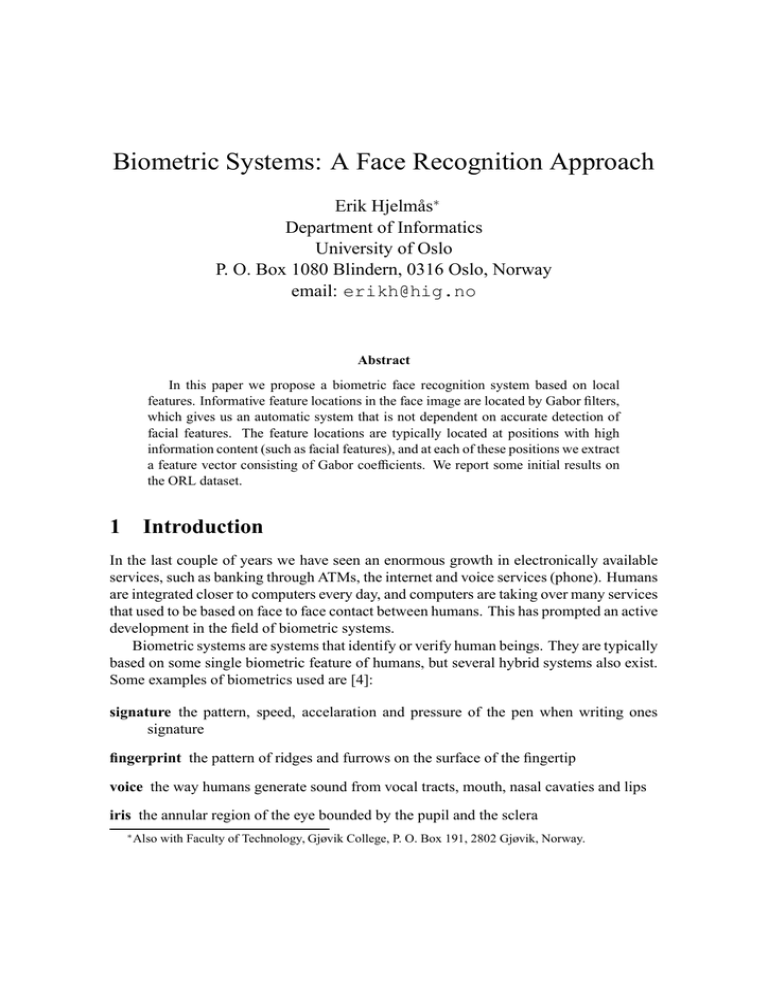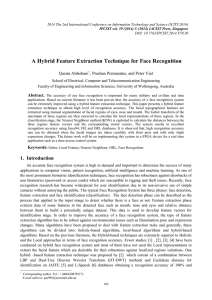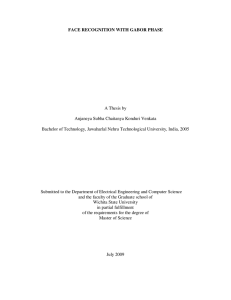Biometric Systems: A Face Recognition Approach
advertisement

Biometric Systems: A Face Recognition Approach
Erik Hjelmås∗
Department of Informatics
University of Oslo
P. O. Box 1080 Blindern, 0316 Oslo, Norway
email: erikh@hig.no
Abstract
In this paper we propose a biometric face recognition system based on local
features. Informative feature locations in the face image are located by Gabor filters,
which gives us an automatic system that is not dependent on accurate detection of
facial features. The feature locations are typically located at positions with high
information content (such as facial features), and at each of these positions we extract
a feature vector consisting of Gabor coefficients. We report some initial results on
the ORL dataset.
1 Introduction
In the last couple of years we have seen an enormous growth in electronically available
services, such as banking through ATMs, the internet and voice services (phone). Humans
are integrated closer to computers every day, and computers are taking over many services
that used to be based on face to face contact between humans. This has prompted an active
development in the field of biometric systems.
Biometric systems are systems that identify or verify human beings. They are typically
based on some single biometric feature of humans, but several hybrid systems also exist.
Some examples of biometrics used are [4]:
signature the pattern, speed, accelaration and pressure of the pen when writing ones
signature
fingerprint the pattern of ridges and furrows on the surface of the fingertip
voice the way humans generate sound from vocal tracts, mouth, nasal cavaties and lips
iris the annular region of the eye bounded by the pupil and the sclera
∗
Also with Faculty of Technology, Gjøvik College, P. O. Box 191, 2802 Gjøvik, Norway.
retina the pattern formed by veins beneath the retinal surface in an eye
hand geometry measurements of the human hand
ear geometry measurements of the human ear
facial thermogram the heat that passes through facial tissue
face the most natural and well known biometric
The rest of this paper is dedicated to presenting our approach to biometric systems, which
is based on face recogniton. In section 3 we present the datasets we report results on, and
section 4 provides an overview of our proposed face recognition algorithm, while section
5 and 6 goes somewhat more into details of our approach to feature detection, extraction,
and recognition. Our experimental results are presented in section 7, while we conclude
og discuss future directions in section 8.
2 Face recognition
The problem of face recognition in cluttered scenes, is a typical task in which humans are
still superior to machines. Several algorithms have been proposed and implemented in
computers [2], but most of them rely on accurate detection of facial features (e.g. exact
location of eye corners) or some kind of geometrical normalization. In this paper we take
a more general approach, and propose an algorithm which relies only on general face
detection.
The face recognition problem is usually approached in one of two ways:
Face recognition (identification) Given a probe face-image and a gallery of class-labelled
faces, find the correct class-label for the probe image. In other words; “Who am
I?”.
Face verification (authentication) Given a class-labelled probe face-image, decide if
the probe image has correct class-label. In other words; “Confirm that I am person X”.
Our proposed algorithm can be applied in both cases, but in this paper we focus on recognition (identification).
Face recognition systems developed so far can roughly be classified as belonging to
the “holistic feature” category or in the “local features” category. Most of the systems
in the ”holistic feature” category are based on PCA (eigenfaces) or similar approaches
(fisherfaces, LDA or PCA combined with LDA) [9] [10] [1]. The “local features” category
mostly consist of systems based on graph matching or dynamic link matching [5] [7] [6],
or some derivative from these. Our system also belongs in this category and uses the
same approach for feature description as most other local features system do, namely
Gabor coefficients.
Our approach differs from previous ones in the sense that it automatically locates informative image regions which is used for feature extraction. We name these informative
image regions “feature locations”. Graph matching approaches, on the other hand, try to
automatically locate local features by superimposing an adaptive grid on a face image.
Other local feature-based approaches try to automatically locate specific facial features
such as eyes, nose and mouth [?]. Graph matching approaches are sensitive to facial occlusions and large variations in face images due to facial hair and expression, while other
feature-based approaches which try to automatically locate facial features are sensitive
to correct detection of the facial features. In our approach we attempt to get past these
shortcoming by avoiding the use of geometrical information available in a graph, and also
by avoiding the detection of pre-determined facial features.
3 Datasets
To initially test our system, we have used the ORL (Olivetti Research Laboratoy) dataset.
The ORL dataset consists of 10 face images from 40 subjects for a total of 400 images,
with some variation in pose, scale, facial expression and details. The resolution of the
images are 112×92, with 256 gray-levels.
4 Overview of the algorithm
We have two separate algorithms for training and testing (algorithm 1 and 2). However,
the basic procedure is equivalent in both algorithms. When processing a face image (either
for training or testing), we filter the image with a set of Gabor filters as described in the
next section. Then we multiply the filtered image with a 2-D Gaussian to focus on the
center of the face, and avoid extracting features at the face contour. This Gabor filtered
and Gaussian weighted image is then searched for peaks, which we define as interesting
feature locations for face recognition. At each peak, we extract a feature vector consisting
of Gabor coefficients and we also store the location and class label. A visualized example
from the testing algorithm is shown in figure 1.
5 Feature detection and localization
We wish to find locations in the face image with high information content. Typically these
are located around the eyes, nose and mouth. We are not interested in the face contour or
hair, since we know that the most stable and informative features in the human face are
located in the center of the face. To enforce this we apply Gaussian weighting to focus
our attention on the center of the face.
Algorithm 1 The training algorithm.
1. Gabor filter face image
2. apply Gaussian weighting
3. locate peaks in image
4. extract feature vector at located peaks
5. if this is first training image of subject, store feature vector, location and class label
for all extracted peaks, else store only those who are misclassified (with respect to
the current gallery)
Algorithm 2 The testing algorithm.
1. - 4. same as training algorithm
2. for each extracted feature vector, compute distance to all feature vectors in gallery
3. based on class label to the nearest matching feature vectors, assign points to corresponding class
(a) original
image
(b) Gabor
filtered
image
(c)
2-D
Gaussian
(d)
Gabor*Gauss
(e) located
feature
points
Figure 1: Example of the face recognition procedure (training algorithm). In (e), the
black cross on a white background indicates an extracted and stored feature vector at this
location while white cross on black bacground indicates an ignored feature vector.
Figure 2: Example of Gabor filters (five sizes and eight orientations).
5.1 Filtering for information
There are several possible ways to find locations with high information content. We intend
to pursue and explore several approaches in the extension of this work, but for now we
have selected the Gabor filter appraoch. The Gabor filters ψk (figure 2) are generated
from a wavelet expansion of a Gabor kernel, parameterized (determining the wavelength
and orientation) by the vector k [5]:
2
2
k2 − k x2 2 ikx
− σ2
2σ
e
,
ψk (x) = 2 e
−e
σ
where
!
kν cos φµ
,
k=
kν sin φµ
kν = 2−
ν+2
2
π,
π
φµ = µ .
8
(1)
(2)
For filtering we use kernels of three sizes (ν ∈ {1, 2, 3}) and eight orientations
(µ ∈ {0, ..., 7}), manually selected based on image resolution. The resulting filtered
image consists of the sum of the magnitudes of the Gabor filter coefficents at each location in the image. The magnitude from the filter is good to apply in this case due to its
smoothly changing behavior [5]. A typical Gabor filtered image is shown in figure 1b.
After Gaussian filtering this image, we end up with the image in figure 1d, which exhibits
the kind of behavior we are looking for (namely high values around interesting locations
such as the eyes nose and mouth).
5.2 Selecting maximas
To select the maximas (peaks) from the image in figure 1d we scan the image with a ω×ω
window and select locations satisfying the following constraints:
1. center pixel value is larger than all other pixel values in window
2. all pixel values are above average pixel value in the entire face image
At each such location we apply the feature extraction procedure described in the next
section. Initially we have manually selected ω = 7.
6 Representation and recognition
6.1 Feature extraction and representation
At each feature location (peak) x we would like to extract a feature vector which describes
the local neighbourhood surrounding x. We choose to do this in the same manner as
the system of Lades et al. [5], namely with a set of Gabor filters (similar to the filtering
procedure described in the previous section, but with different kernel sizes). For the Gabor
filtering we used kernels of three sizes. For the feature extraction and representation we
use an additional smaller and an additional larger kernel which gives us a 40-dimensional
feature vector consisting of the magnitudes of the complex Gabor coefficients.
During training, the extracted feature vectors are stored in the gallery according to the
rule “if this is the first training image of the subject, store all extracted feature vectors, if
not: for each extracted feature vector find the closest feature vector already stored in the
gallery and compare the class labels, if the class labels match ignore the feature vector,
otherwise add to the gallery”. The reason for applying this rule is that we do not have any
intention of establishing classes in feature space (the gallery). We want a gallery consisting of single feature locations with high information content, thus we want to add only
feature vectors which add new information to the gallery (and not “overpopulate feature
space”). The above rule is a rough approximation to this, but some initial experiments
have shown that performance does not decrease due to this rule.
6.2 Classification
Initially we compute Euclidian distance to all feature vectors in the gallery and rank them
accordingly. Furthermore, we apply two strategies for classification. One is to see how
well we can do with a single feature location. In this case we select the feature vector (of
all the extracted feature vectors in the current test image) which is closest to (in Euclidian
distance) some feature vector in the gallery and assign this test image the class label of
that feature vector. The second strategy involves all the extracted feature vectors in the test
image. In this case (for each feature vector) we select a number n of the closest feature
vectors in the gallery, and assign (award) points, ranging from n (best match) to 1, to the
possible classes. For each class we sum the number of points assigned by each extracted
feature vector. The test image is assigned the class label of the class with the most points.
7 Experimental results and discussion
In [3], we examined how well we could do in face recognition if the only available information were the eyes. On the ORL dataset, we reported 85% correct classification
with feature vectors consisting of Gabor coefficients, which was the best result compared
to eigenfeatures (PCA) and gray-level features. From this we know that we can do reasonably well with only a few feature locations, but of course we want to use as much
information as possible.
Figure 3 shows results when only the single best matching feature vector is used (as
described in the previous section). The results are reported in terms of cumulative match
score [8], and all results are the average of 10 trials where the dataset is randomly divided
into 5 images for training and 5 images for testing (for each subject). We observe that
this does not give satisfactory performance (only 76.5% for rank = 1), which is expected
considering we only use a very small amount of information from the face image. In this
situation the classification is based only on the match of a single automatically extracted
feature vector in the image to a stored one in the gallery (e. g. only a small neighbourhood
surrounding the nose tip).
In our second strategy, where we make use of all located feature locations, we would
expect better performance. Figure 4 shows the results in this case, where “score” is percentage correct classification and n indicates the number of classes we assign (award)
points to. We observe that performance is better (83.4% for n ∈ {2, 3, 4}) than for the
single feature strategy, but not as good as expected. These results are not yet competitive
with the best performing systems, since many systems perform 95% or better on the ORL
dataset. Our task at hand is to find a better trade off between extracting information and
avoiding noise. As we see from figure 4, performance increases when we increase n from
1 to 2, but decreases whenever n > 4 increases, which means that utilizing the lower
ranked feature vectors only adds noise to the system at this level.
8 Conclusions and future work
We have presented a feature-based biometric face recognition system together with some
initial experimental results. Future work will involve detailed exploration of each component in the system, specifically parameter tuning and classification strategies.
Acknowledgements
We would like to thank the Olivetti Research Laboratory for compiling and maintaining
the ORL face-database, and Rama Chellappa, Fritz Albregtsen and Jørn Wroldsen for
useful discussions during the preparation of this work. This work was supported by the
1
0.9
0.8
cumulative match score
0.7
0.6
0.5
0.4
0.3
0.2
0.1
0
0
10
20
30
40
50
60
70
80
90
100
rank
Figure 3: Performance when only the best matching single feature is used for classification.
1
0.9
0.8
0.7
score
0.6
0.5
0.4
0.3
0.2
0.1
0
0
10
20
30
40
50
60
70
80
90
100
n
Figure 4: Performance when we assign points from all extracted feature vectors.
Research Council of Norway and was partially done while E. Hjelmås was visiting Center
for Automation Research, University of Maryland.
References
[1] P. N. Belhumeur, J. P. Hespanha, and D. J. Kriegman. Eigenfaces vs. Fisherfaces:
Recognition Using Class Specific Linear Projection. IEEE Transactions on Pattern
Analysis and Machine Intelligence, 19(7), 1997.
[2] R. Chellappa, C. L. Wilson, and S. Sirohey. Human and Machine Recognition of
Faces: A Survey. Proceedings of the IEEE, 83(5), 1995.
[3] E. Hjelmås and J. Wroldsen. Recognizing Faces from the Eyes Only. In Proceedings
of the 11th Scandinavian Conference on Image Analysis, 1999.
[4] A. Jain, L. Hong, and S. Pankanti. Biometric Identification. Communications of the
ACM, 43(2), 2000.
[5] M. Lades, J. C. Vorbrüggen, J. Buhmann, J. Lange, C. von der Malsburg, R. P.
Würtz, and W. Konen. Distortion Invariant Object Recognition in the Dynamic Link
Architecture. IEEE Transactions on Computers, 42(3), 1993.
[6] B. S. Manjunath, R. Chellappa, and C. von der Malsburg. A Feature Based Approach
to Face Recogntion. In Proc. of IEEE Computer Society Conference on Computer
Vision and Pattern Recognition, 1992.
[7] K. Okada, J. Steffens, T. Maurer, H. Hong, E. Elagin, H. Neven, and C. von der
Malsburg. The Bochum/USC Face Recognition System and How it Fared in the
FERET Phase III Test. In Face Recognition: From Theory to Applications. SpringerVerlag, 1998.
[8] P. J. Phillips, H. Moon, P. Rauss, and S. A. Rizvi. The FERET September 1996
Database and Evaluation Procedure. In Proceedings of the First International Conference on Audio and Video-based Biometric Person Authentication, 1997.
[9] M. Turk and A. Pentland. Eigenfaces for Recognition. Journal of Cognitive Neuroscience, 3:71–86, 1991.
[10] W. Zhao, A. Krishnaswamy, R. Chellappa, D. L. Swets, and J. Weng. Discriminant
Analysis of Principal components for Face Recognition. In Face Recognition: From
Theory to Applications. Springer-Verlag, 1998.


